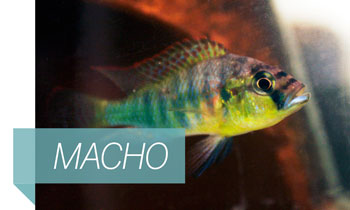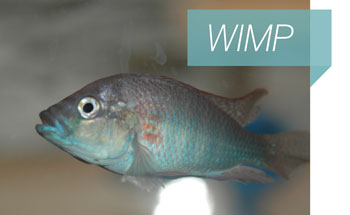For the male African cichlid fish, everyday can be a battle to gain rights to prime real estate and girls. Though the aquariums in Hans Hofmann’s lab in Patterson Hall are not like the fight-to-the-death arena of “The Hunger Games,” they are still the scenes of epic competition and showmanship.
Meet, for example, the macho male. His body is awash in hues of green, yellow and pink spots. A band of black masks his eyes. The dastardly devil has huge testicles, but you can’t see them. They are hidden inside his body.
When the macho is challenged by a wimp, the game is on.
“They will engage over a course of several days in ritualized aggressive encounters with different displays,” says biologist Hofmann. “Eventually, most likely, they will escalate into all out physical combat where they mouth lock, bite each other, and push each other around.”
 Eventually one male will prevail.
Eventually one male will prevail.
And if the challenger – the previous “wimp” – wins, he will take over the macho’s territory. Within seconds, the new macho will color up, producing bright yellow, orange and green color patterns across his body. The loser will turn dull gray.
Other hormonally regulated changes will take a few days. Eventually, the loser will join other non-dominant males in a school of losers hanging with females and juveniles.
The dominant male's gonads will start to grow. Within a week or so, they double or triple in size, sometimes even more.
“While that is happening, the animals turn on an entire biochemical machinery that allows them to produce a lot of sperm and androgens like testosterone,” says Hofmann. “They need this testosterone in their circulation to sustain their aggressive behavior and maintain their territory.”
The wimp’s gonads may shrink to such a size that he couldn’t even reproduce if he wanted to do.
That biochemical machinery is exactly where the Hofmann lab focuses its attention. The team is peering into the brains of these cichlids in an effort to understand broadly how animals, including ourselves, make decisions within social contexts, and how those decision-making processes have evolved over the millennia.
 Hofmann says that social dominance interactions between males or females when choosing a mate are the perfect context for these studies because they are very common across the animal kingdom, and they are important decisions that we make, too.
Hofmann says that social dominance interactions between males or females when choosing a mate are the perfect context for these studies because they are very common across the animal kingdom, and they are important decisions that we make, too.
“In my lab, we use a whole range of techniques, from behavioral tests to molecular biology and genomics, to get at the underlying mechanisms of these behaviors,” he says.
The fascinating thing about the cichlid is that so many changes can be observed within a very short time period in the controlled situation of the laboratory aquariums.
By analyzing the fish’s hormones and genomes in concert with their behavior, the researchers are beginning to understand what actually happens in the brain areas that are involved in regulation of social behavior and mating at the level of genes and hormonal signaling.
From outside the aquarium, it just looks like fight, and it is kind of fun to watch. On the inside, the fish’s neurons are firing, its genes are rapidly expressing, its hormones are circulating, and its behaviors are changing. And the researchers are standing by…

















Comments